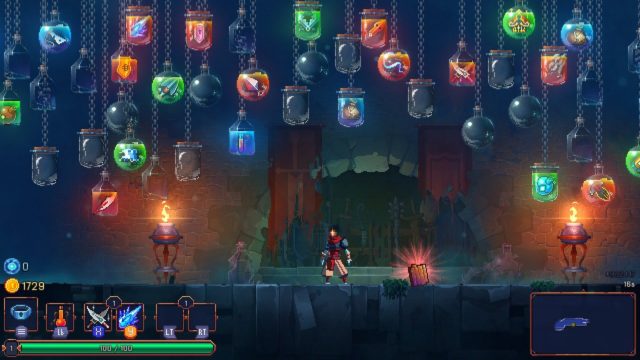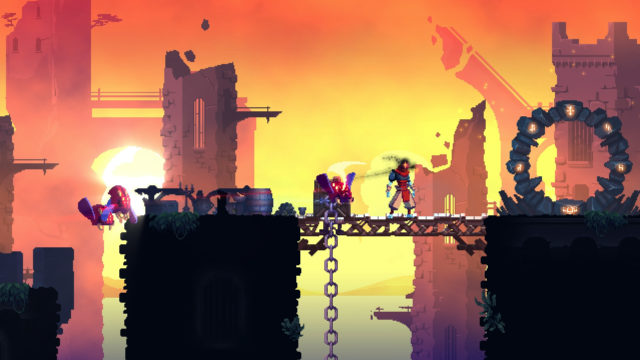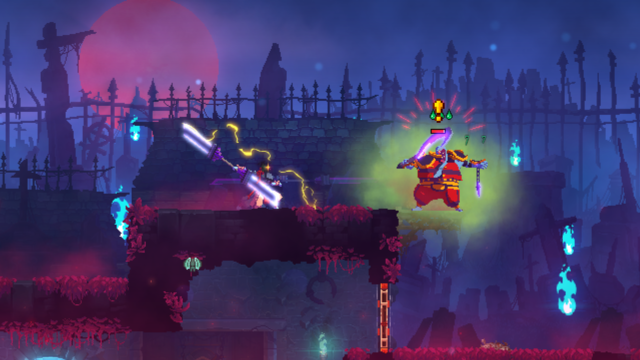Expressive animations coupled with an atmospheric, gorgeous game world; over-the-top melee and ranged combat with a ton of gear to unlock; upgrade system is perfectly implemented; heaping helping of replay value
Lack of a defined narrative is a wasted opportunity- there's so much personality on display here that the game practically demands a full-fledged storyline; while the procedurally generated stages feel very cohesive, some real set pieces would have been a plus
I have a buddy who can’t stand procedurally generated games. He doesn’t like the pacing problems that arise from their lack of intentional design, as well as the inability to savor the spaces within them due to their finite nature. I tend to agree, but there are always exceptions to the rule— I’d count SteamWorld Heist, Spelunky, and The Binding of Isaac amongst them. Those games managed to mix the randomness of the roguelike subgenre with genuinely engrossing gameplay mechanics and points of interest that belie the spontaneity of their stage and world structures. Dead Cells, from developer Motion Twin, is the latest title to take a stab at the procedurally generated formula, but does it succeed like the other games I mentioned?
Yes and no. Dead Cells comes very close to being one of the best platformers of this generation, but a handful of deficiencies hold it back. The game starts out in the execution chamber of a bleak, filthy prison. Players are greeted by the sight of a freshly killed convict, his form slumped over and bleeding out onto the ground. Dead Cells‘ lead is actually a series of random headless prisoners’ corpses that are perpetually revived by a rolling blob of green muck. With every death that the player suffers (which happens a lot), the blob latches onto the top of the next new body’s torso and transfers its essence within. As the spirit is infused into the cadaver, a burst of flame erupts from the neck and the corpse becomes ambulatory once more. It’s freaky. It’s disturbing. It’s… gross!
A lot of Dead Cells is gross, honestly, and that’s a huge part of its charm. Walls are slick with slime and blood, enemies are monstrous, and indeed, so are many of the allies. Yet, for all of its grime, Dead Cells is also astonishingly beautiful. The environments are flooded with details and boldly colored. There are also a litany of secrets squirreled away, as well. Given how gorgeous and refined the different stages are, it’s a wonder that they’re randomly generated, but that’s part of what makes Dead Cells so special.
Motion Twin refers to the combat in Dead Cells as “souls-lite.” Souls-lite emphasizes the importance of memorizing patterns from bosses and lesser foes alike in order to survive. All of the weaponry/equipment in the game is split into three categories: Brutality, Survival, and Tactics. These designations correlate to melee, defensive, and ranged gear. Only through a mix of these gear types will players be able to escape the prison. There’s a good amount of enemy variety and they’re all very tough to fight. There are no cheap outs here, either. Players have to comb for better weapons and utilize various “tells” or signals from foes to know when to dodge and avoid damage. A rhythm quickly develops and combat becomes a mesmerizing swirl of sword swings, rolls, and a plethora of explosions and shot arrows.

This difficulty is a huge part of Dead Cells‘ allure and it extends to the permadeath feature that Motion Twin has employed here. Every death is a “game over” in Dead Cells. With every rebirth, the hero must start fresh each time, from the execution chamber all the way back to the end. It’s merciless, but that’s the point. There’s lighter fare available from all sorts of different publishers, so I applaud Motion Twin for taking this risk. Dead Cells doesn’t coddle and it’s refreshing. It expects the player to learn its mechanics, master them, and continuously adapt in the face of adversity. Don’t let that scare you away, though, because Dead Cells is as fair as it is tough.
One way this fairness is achieved is via the game’s upgrade system. Scattered throughout each section of the prison are scrolls that will allow the hero to enhance either his Brutality, Survival, or Tactics slots. These scrolls are fairly liberally placed, but the game does what it can to make players diversify their selection each time by limiting how much a given stat will increase if it’s repeatedly chosen. It’s a great way to get players experimenting with the three branches of abilities, which is important because a mixture of them is the only way to progress deeply into the prison.

There are also blueprints for new weapons and gear littered about that, once found and built, are permanently unlocked thereafter. This is significant because Dead Cells starts off with really meager weapons and shields to choose from. While there’s no avoiding the game’s permadeath, these additions to the armory mean that the hero has a greater array of items to choose from with each new life, making it easier to traverse the prison. It’s really a masterclass what Motion Twin has achieved here in terms of game design. Everything compels the player to keep trying to get to the end, with tangible and genuinely worthwhile rewards for their efforts each time.
It wouldn’t be a Metroidvania without some retreading, but the way Dead Cells goes about it is somewhat innovative compared to similar titles. I talked about the temporary upgrades available in the game, but there are permanent ones, as well. They generally grant new abilities that allow the hero to get to (wait for it) previously unreachable areas. That’s pretty standard for a Metroidvania, but the roguelike random stage designs mean it’s not the typical task of remembering points in the game map that need to be returned to. Instead, these new abilities encourage further exploration. The stage layouts might be random, but they always contain corridors that lead to hidden areas and items, so having more abilities means more things can be uncovered.
Unfortunately, if there’s any area where Dead Cells falls flat, it’s in the game’s narrative. The storyline is sparse, which is no sin, of course. Not every game depends on a deep story and, as I am known to preach, gameplay is paramount above all. Yet, Dead Cells is so virtually flawless in every other aspect that the lack of a more prominent and detailed narrative is glaring. The game world is so vivid and organic, its enemies so visually arresting, the atmosphere so foreboding, and the side characters so interesting, that Dead Cells practically demands a true storyline to fully flesh-out what is teased. There are little curiosities like writings scattered about that further allude to some of the underlying storyline, but it’s just not enough.

Beyond that grievance, Dead Cells‘ only other real problem is a lack of gameplay variety. Yes, there are the abilities I discussed that carry over between deaths, but ultimately Dead Cells‘ various locales start to bleed together in the sense that they all provide the same basic challenge of unrelenting foes that must be eliminated via melee or distanced attacks. While something like Metroid mixes things up with Morph Ball segments or even sections of pure exploration, Dead Cells leans exclusively on its combat, which can start to feel stale after hours of play. I said “hours” on purpose, because any stagnation that sets in takes some time to do so, but it does eventually crop up and that can’t be ignored.
Dead Cells likely won’t convert any roguelike detractors, but it’s a wildly creative and fun title nonetheless. Its game world, characters, and enemies all drip personality. The combat is fluid and gritty, there’s a ton to upgrade and unlock, and it’s easy to get lost for hours within Dead Cells‘ world. While a more prominent storyline and some memorable set pieces would go a long way towards elevating this to being one of the premier platformers of this console generation, Dead Cells remains a must-have. I can’t wait to see what Motion Twin does next.




 ShareThis
ShareThis





